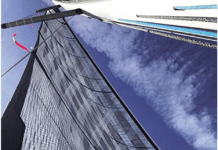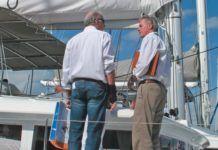How to Sell Your Boat
For many sailors, selling their boats is an emotional experience. The big decision is setting the price. Setting your price, or the acceptable net...
Must New Owners Pay Old Yard Bills?
Unless the Purchase and Sale Agreement or the Acceptance of Vessel forms specify otherwise, the buyer is responsible for any work that is done...
Drawing the Line on Boat Design
A New Zealander greatly influenced by the traditional craft of the Pacific and Indian Oceans, famed multihull designer Ian Farrier understood that an enduring design goes through several evolutions. Proas, the small sailing craft of Micronesia that inspired his visionary folding trimaran design, presented a perfect example of this.
Selling your Sailboat
You want to sell your boat. And youd like to sell it quickly. What can you do to make that happen? We recently interviewed several brokers and surveyors for advice on what helps, what hurts, and what flaws are sure to come to light when you are trying to sell your boat. Remember that the savvy buyer will always overemphasize the unknown, believing that for every fault they uncover there are three more lurking, and that these will cost more to set right than you say or they think. Fortunately, a well-maintained boat can often be prepped for sale with a relatively small investment in time and money. And if the boat hasn't been maintained, youll want to prioritize the tasks required to draw a willing buyer.
Practical Sailor 2016 Index
Practical Sailor 2016 Index
Diving into the Endeavour 42
Just as the Caribbean cruising dream was at its peak in the American consciousness, Endeavour yachts brought in Americas Cup designer Johan Valentijn to create a new breed of Endeavours to compete with an already crowded field of center-cockpit cruisers, most of them bound for the Caribbean charter trade. The end result was a boat that managed to maintain a surprisingly tolerable aesthetic, unlike the typical wedding-cake center cockpit cruiser. The combination of teak trim, bootstripe, and balanced proportions camouflages what is essentially a floating condo.
Mailport: Water Lift Muffler, Drogues, Hunter 30, and More!
After corrosion destroyed the water-lift muffler aboard his 1972 Irwin 37 (above) and he could not find a replacement, subscriber Gene Millard fabricated his own.
Stiletto 27: The Beachcat Grown Up
Its hard to mistake the Stiletto 27s appearance-typically with blazing topside graphics and aircraft-style, pop-top companionway hatches. Its also hard for the average sailor to appreciate the sophistication of the Stilettos construction-epoxy-saturated fiberglass over a Nomex honeycomb core. There is probably no production hull built in the U.S. with a better strength-to-weight ratio than the Stiletto. And although the design is 40 years old, the Nomex honeycomb fabrication is still impressive.
Stiletto Foiler on Horizon
This summer, Stiletto Manufacturing will be launching the all-new Stiletto X-Series, including a foiling catamaran, with the first boats expected to splash about the time this article went press. Carrying on the Stiletto tradition, the 10-meter X-Series models are being marketed as high-performance boats that are fast, beachable, trailerable, and affordable, as well as easy to handle and ideal for coastal family getaways.
Columbia 8.7
For better or worse, the Columbia 8.7 is modern in appearance, with a very straight sheer, pronounced forward overhang, and no overhang aft. The stern is decidedly unusual, with an exaggerated wineglass-section transom. This reduces the apparent size of the back end of the boat, which would otherwise look very ungainly since beam is carried well aft. From an aesthetic point of view, you either like the stern or you don't.
















































